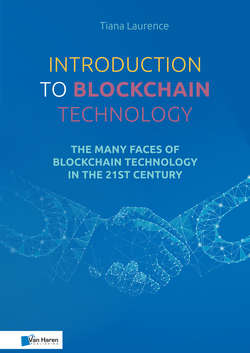Читать книгу Introduction to Blockchain Technology - Tiana Laurence - Страница 16
На сайте Литреса книга снята с продажи.
1.3 Test your knowledge
Оглавление1. What is a blockchain?
A. A blockchain is a node time stamper that holds a record of all transactions that have ever occurred on that network.
B. A blockchain is a time-stamp server that holds a record of all transactions that have ever occurred on that network.
C. A blockchain is a peer-to-peer distributed time-stamp server that holds a record of all transactions that have ever occurred on that network.
D. A blockchain is a peer-to-peer distributed time-stamp server that holds some of the records of the blockchain.
2. What is a hash function in the context of a blockchain?
A. A hash function is a mathematical problem that creates an output called a string. These are numbers and letters of any size; for Bitcoin it is 72 bytes.
B. A hash function adds blocks to the blockchain. And it is the output of a mathematical process that creates a string of numbers and letters of a fixed-size; for Hyperledger it is 32 bytes.
C. A hash function is used to open up all the data in a block. A hash is the output of this mathematical process that creates a string of numbers and letters of a fixed-size; for Bitcoin it is 82 bytes.
D. A hash function is used to secure all the data in a block of transactions. A hash is the output of this mathematical process that creates a string of numbers and letters of a fixed-size; for Bitcoin it is 32 bytes.
3. What is a node?
A. A node is a computer that is connected to a blockchain network. It runs the software for the network and keeps the network healthy by transferring information across the network to other nodes.
B. A node is connected to a blockchain network through the internet. It lets you buy bitcoin.
C. Nodes are special computers that build blocks. They keep the network running by storing information.
D. A node transfers information across the network to other nodes.
4. What is the three-phase process for Fabric?
A. One -write a smart contract, two - the endorsed transactions are collected, three - the new block is broadcast back to every peer.
B. One - an update to the ledger is requested, two - the new block is broadcast back to every peer.
C. One - an update to the ledger is requested, two - the endorsed transactions are collected, three - the new block is broadcast back to every peer.
D. One - an update to the ledger is requested, two - the endorsed transactions are collected, three - the node records the transaction in its ledger.
5. What is a public blockchain network?
A. A public blockchain allows some people to participate at any level they want. All have some form of mining and a token.
B. A public blockchain allows anyone to participate if they identify themselves first. All have some form of mining and a native cryptocurrency.
C. A public blockchain allows anyone to participate at any level they want. None of them have mining or a native cryptocurrency.
D. A public blockchain allows anyone to participate at any level they want. All have some form of mining and a native cryptocurrency.
6. What is a permissioned blockchain network?
A. A permissioned blockchain is an open network that utilizes all blockchain technology. Most have mining and no native cryptocurrency.
B. A permissioned blockchain is a private network that utilizes some blockchain technology including mining for cryptocurrency.
C. A permissioned blockchain is a closed network that is run on one server. They utilize some blockchain technology but not all. Most don’t have mining or any native tokens.
D. A permissioned blockchain is a private network that utilizes some blockchain technology but not all. Most don’t have mining or any native cryptocurrency.
7. What is a hybrid blockchain network?
A. A hybrid network gates full access to its blockchain network. Many have some form of mining and a native cryptocurrency.
B. A hybrid network does not gate access to its blockchain network. Many don’t have any form of mining or a native cryptocurrency.
C. A hybrid network gates full access to its cryptocurrency. Many have some form of mining and a native cryptocurrency.
D. A hybrid network is not a blockchain network. Many have some form of mining and a native cryptocurrency.
8. What is a federated blockchain network?
A. A federated blockchain can’t be a public blockchain. Users of the system elect nodes to process transactions.
B. A federated blockchain can be a public blockchain or a private blockchain. Users of the system elect nodes to process transactions.
C. A federated blockchain is always a public blockchain. Users of the system elect nodes to process transactions.
D. A federated blockchain allows users of the system to elect nodes to process transactions.
9. What causes price volatility of cryptocurrencies?
A. Cryptocurrency price is driven up and down only by government sanctions.
B. Cryptocurrency price is driven up and down only by pump and dump scams.
C. Cryptocurrency price is driven up and down by speculation, scarcity and utility.
D. Cryptocurrency price is driven up and down only by utility.
10. How are Merkel tree roots used to stabilize hybrid blockchains?
A. Merkle tree root is a type of hardware manufacturer who builds mining chips.
B. Merkle tree root allows everyone to view information that was published.
C. Merkle tree root allows the Bitcoin blockchain to restore itself to its last known valid block in case the network is attacked.
D. Merkle tree root allows a hybrid blockchain to restore itself to its last known valid block in case the network is attacked.
